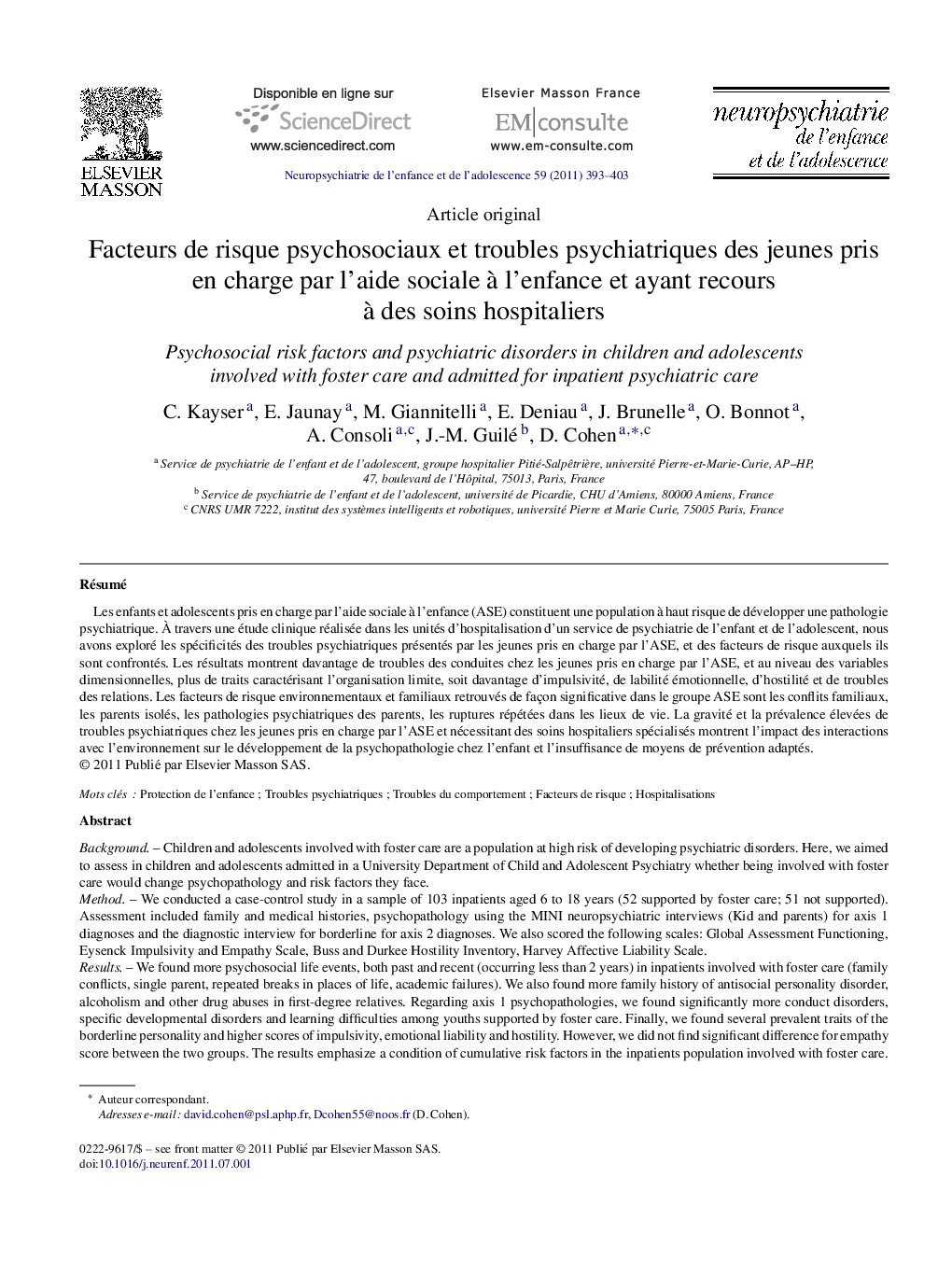| کد مقاله | کد نشریه | سال انتشار | مقاله انگلیسی | نسخه تمام متن |
|---|---|---|---|---|
| 944177 | 925585 | 2011 | 11 صفحه PDF | دانلود رایگان |

RésuméLes enfants et adolescents pris en charge par l’aide sociale à l’enfance (ASE) constituent une population à haut risque de développer une pathologie psychiatrique. À travers une étude clinique réalisée dans les unités d’hospitalisation d’un service de psychiatrie de l’enfant et de l’adolescent, nous avons exploré les spécificités des troubles psychiatriques présentés par les jeunes pris en charge par l’ASE, et des facteurs de risque auxquels ils sont confrontés. Les résultats montrent davantage de troubles des conduites chez les jeunes pris en charge par l’ASE, et au niveau des variables dimensionnelles, plus de traits caractérisant l’organisation limite, soit davantage d’impulsivité, de labilité émotionnelle, d’hostilité et de troubles des relations. Les facteurs de risque environnementaux et familiaux retrouvés de façon significative dans le groupe ASE sont les conflits familiaux, les parents isolés, les pathologies psychiatriques des parents, les ruptures répétées dans les lieux de vie. La gravité et la prévalence élevées de troubles psychiatriques chez les jeunes pris en charge par l’ASE et nécessitant des soins hospitaliers spécialisés montrent l’impact des interactions avec l’environnement sur le développement de la psychopathologie chez l’enfant et l’insuffisance de moyens de prévention adaptés.
BackgroundChildren and adolescents involved with foster care are a population at high risk of developing psychiatric disorders. Here, we aimed to assess in children and adolescents admitted in a University Department of Child and Adolescent Psychiatry whether being involved with foster care would change psychopathology and risk factors they face.MethodWe conducted a case-control study in a sample of 103 inpatients aged 6 to 18 years (52 supported by foster care; 51 not supported). Assessment included family and medical histories, psychopathology using the MINI neuropsychiatric interviews (Kid and parents) for axis 1 diagnoses and the diagnostic interview for borderline for axis 2 diagnoses. We also scored the following scales: Global Assessment Functioning, Eysenck Impulsivity and Empathy Scale, Buss and Durkee Hostility Inventory, Harvey Affective Liability Scale.ResultsWe found more psychosocial life events, both past and recent (occurring less than 2 years) in inpatients involved with foster care (family conflicts, single parent, repeated breaks in places of life, academic failures). We also found more family history of antisocial personality disorder, alcoholism and other drug abuses in first-degree relatives. Regarding axis 1 psychopathologies, we found significantly more conduct disorders, specific developmental disorders and learning difficulties among youths supported by foster care. Finally, we found several prevalent traits of the borderline personality and higher scores of impulsivity, emotional liability and hostility. However, we did not find significant difference for empathy score between the two groups. The results emphasize a condition of cumulative risk factors in the inpatients population involved with foster care.ConclusionThe severity and prevalence of psychiatric disorders among youths involved with foster care and requiring psychiatric inpatient stay show the impact of interactions with the environment on the development of psychopathology in children and, for some of them, the inadequacy of the means of prevention.
Journal: Neuropsychiatrie de l'Enfance et de l'Adolescence - Volume 59, Issue 7, November 2011, Pages 393–403